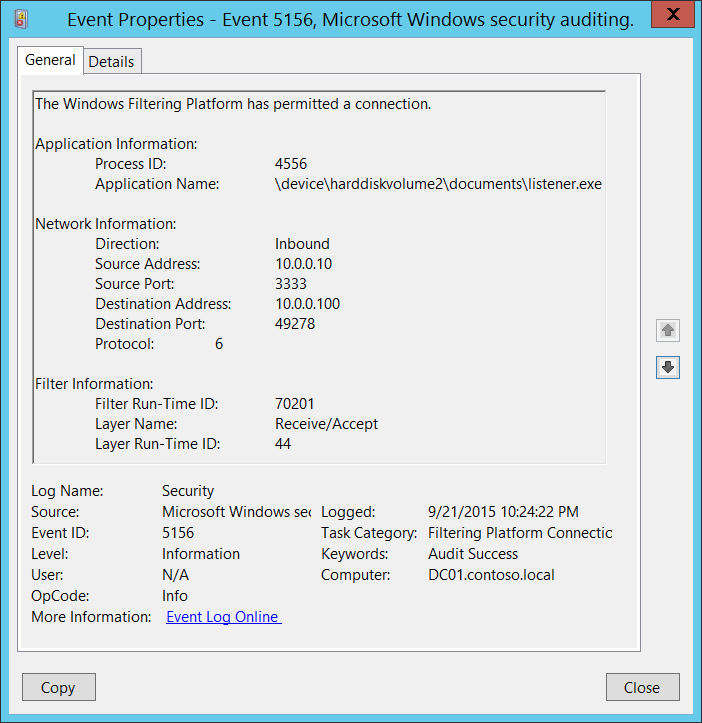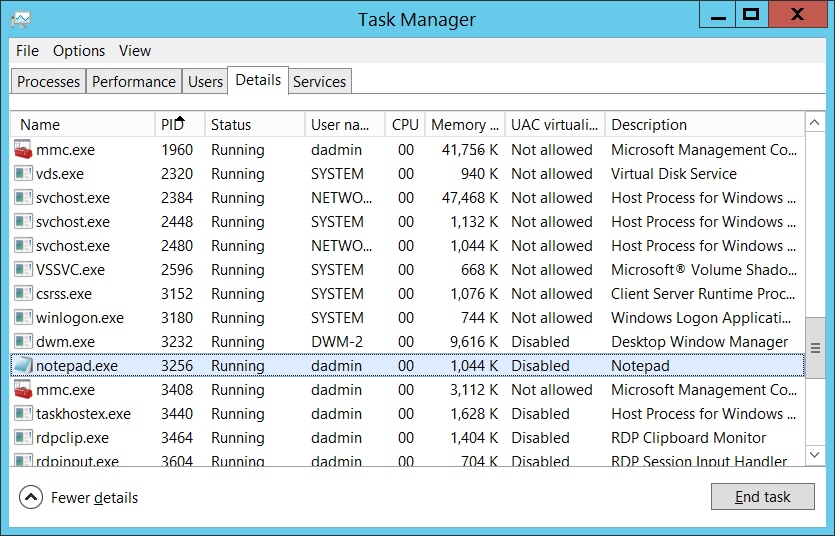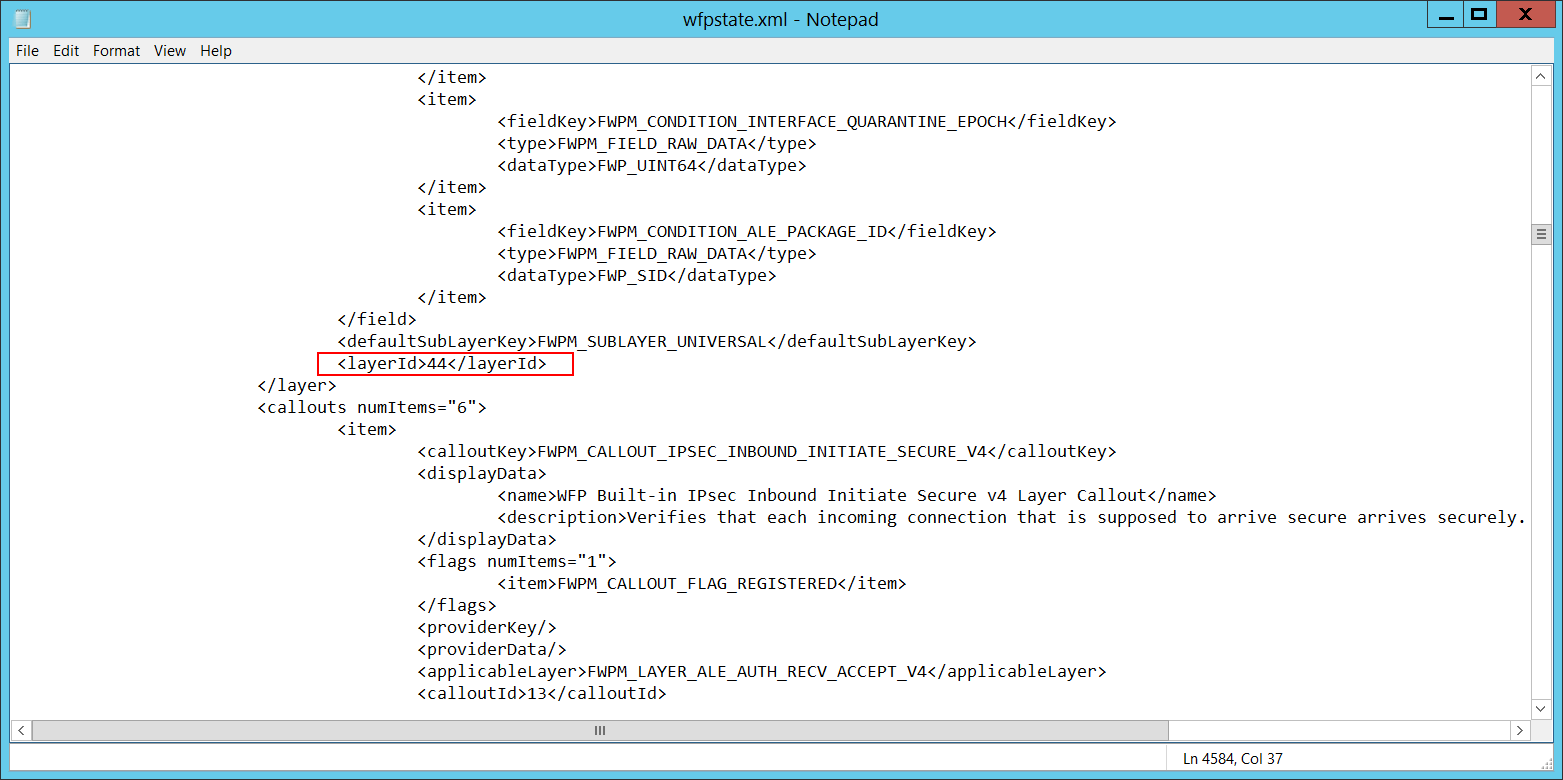5156(S): The Windows Filtering Platform has permitted a connection.

Subcategory: Audit Filtering Platform Connection
Event Description:
This event generates when Windows Filtering Platform has allowed a connection.
Note For recommendations, see Security Monitoring Recommendations for this event.
Event XML:
- <Event xmlns="http://schemas.microsoft.com/win/2004/08/events/event">
- <System>
<Provider Name="Microsoft-Windows-Security-Auditing" Guid="{54849625-5478-4994-A5BA-3E3B0328C30D}" />
<EventID>5156</EventID>
<Version>1</Version>
<Level>0</Level>
<Task>12810</Task>
<Opcode>0</Opcode>
<Keywords>0x8020000000000000</Keywords>
<TimeCreated SystemTime="2015-09-22T05:24:22.622090200Z" />
<EventRecordID>308129</EventRecordID>
<Correlation />
<Execution ProcessID="4" ThreadID="3712" />
<Channel>Security</Channel>
<Computer>DC01.contoso.local</Computer>
<Security />
</System>
- <EventData>
<Data Name="ProcessID">4556</Data>
<Data Name="Application">\\device\\harddiskvolume2\\documents\\listener.exe</Data>
<Data Name="Direction">%%14592</Data>
<Data Name="SourceAddress">10.0.0.10</Data>
<Data Name="SourcePort">3333</Data>
<Data Name="DestAddress">10.0.0.100</Data>
<Data Name="DestPort">49278</Data>
<Data Name="Protocol">6</Data>
<Data Name="FilterRTID">70201</Data>
<Data Name="LayerName">%%14610</Data>
<Data Name="LayerRTID">44</Data>
<Data Name="RemoteUserID">S-1-0-0</Data>
<Data Name="RemoteMachineID">S-1-0-0</Data>
</EventData>
</Event>
Required Server Roles: None.
Minimum OS Version: Windows Server 2008, Windows Vista.
Event Versions: 0.
Field Descriptions:
Application Information:
Process ID [Type = Pointer]: hexadecimal Process ID of the process that received the connection. Process ID (PID) is a number used by the operating system to uniquely identify an active process. To see the PID for a specific process you can, for example, use Task Manager (Details tab, PID column):

If you convert the hexadecimal value to decimal, you can compare it to the values in Task Manager.
You can also correlate this process ID with a process ID in other events, for example, “4688: A new process has been created” Process Information\New Process ID.
Application Name [Type = UnicodeString]: full path and the name of the executable for the process.
Logical disk is displayed in format \device\harddiskvolume#. You can get all local volume numbers by using diskpart utility. The command to get volume numbers using diskpart is “list volume”:

Network Information:
Direction [Type = UnicodeString]: direction of allowed connection.
Inbound – for inbound connections.
Outbound – for unbound connections.
Source Address [Type = UnicodeString]: IP address from which the connection was initiated.
IPv4 Address
IPv6 Address
:: - all IP addresses in IPv6 format
0.0.0.0 - all IP addresses in IPv4 format
127.0.0.1, ::1 - localhost
Source Port [Type = UnicodeString]: port number from which the connection was initiated.
Destination Address [Type = UnicodeString]: IP address where the connection was received.
IPv4 Address
IPv6 Address
:: - all IP addresses in IPv6 format
0.0.0.0 - all IP addresses in IPv4 format
127.0.0.1, ::1 - localhost
Destination Port [Type = UnicodeString]: port number where the connection was received.
Protocol [Type = UInt32]: number of the protocol that was used.
| Service | Protocol Number |
|---|---|
| Internet Control Message Protocol (ICMP) | 1 |
| Transmission Control Protocol (TCP) | 6 |
| User Datagram Protocol (UDP) | 17 |
| General Routing Encapsulation (PPTP data over GRE) | 47 |
| Authentication Header (AH) IPSec | 51 |
| Encapsulation Security Payload (ESP) IPSec | 50 |
| Exterior Gateway Protocol (EGP) | 8 |
| Gateway-Gateway Protocol (GGP) | 3 |
| Host Monitoring Protocol (HMP) | 20 |
| Internet Group Management Protocol (IGMP) | 88 |
| MIT Remote Virtual Disk (RVD) | 66 |
| OSPF Open Shortest Path First | 89 |
| PARC Universal Packet Protocol (PUP) | 12 |
| Reliable Datagram Protocol (RDP) | 27 |
| Reservation Protocol (RSVP) QoS | 46 |
Filter Information:
Filter Run-Time ID [Type = UInt64]: unique filter ID that allowed the connection.
To find a specific Windows Filtering Platform filter by ID, run the following command: netsh wfp show filters. As a result of this command, the filters.xml file will be generated. Open this file and find specific substring with required filter ID (<filterId>), for example:

Layer Name [Type = UnicodeString]: Application Layer Enforcement layer name.
Layer Run-Time ID [Type = UInt64]: Windows Filtering Platform layer identifier. To find a specific Windows Filtering Platform layer ID, run the following command: netsh wfp show state. As a result of this command, the wfpstate.xml file will be generated. Open this file and find specific substring with required layer ID (<layerId>), for example:

Security Monitoring Recommendations
For 5156(S): The Windows Filtering Platform has permitted a connection.
If you have a predefined application that should be used to perform the operation that was reported by this event, monitor events with “Application” not equal to your defined application.
You can monitor to see if “Application” isn't in a standard folder (for example, not in System32 or Program Files) or is in a restricted folder (for example, Temporary Internet Files).
If you have a pre-defined list of restricted substrings or words in application names (for example, “mimikatz” or “cain.exe”), check for these substrings in “Application.”
Check that “Source Address” is one of the addresses assigned to the computer.
If the computer or device shouldn't have access to the Internet, or contains only applications that don’t connect to the Internet, monitor for 5156 events where “Destination Address” is an IP address from the Internet (not from private IP ranges).
If you know that the computer should never contact or should never be contacted by certain network IP addresses, monitor for these addresses in “Destination Address.”
If you've an allowlist of IP addresses that the computer or device is expected to contact or to be contacted by, monitor for IP addresses in “Destination Address” that aren't in the allowlist.
If you need to monitor all inbound connections to a specific local port, monitor for 5156 events with that “Source Port.”
Monitor for all connections with a “Protocol Number” that isn't typical for this device or computer, for example, anything other than 1, 6, or 17.
If the computer’s communication with “Destination Address” should always use a specific “Destination Port,” monitor for any other “Destination Port.”